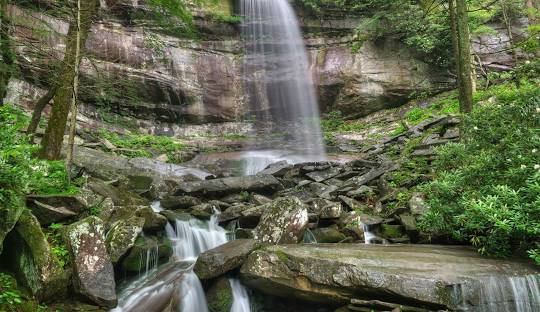Discovering the Enchantment of Rainbow Falls Trail in Hawaii

Exploring the Beauty of Rainbow Falls Trail
Welcome to the breathtaking Rainbow Falls Trail, a hidden gem nestled in the heart of Hawaii. This enchanting trail offers visitors a chance to immerse themselves in the lush beauty of nature while marveling at the majestic Rainbow Falls.
As you embark on this scenic journey, you will be greeted by a canopy of vibrant green foliage, towering trees, and the soothing sound of cascading water. The trail meanders through dense forests, across babbling streams, and past ancient lava formations, providing a truly immersive experience for nature enthusiasts.
One of the highlights of the Rainbow Falls Trail is, of course, the iconic Rainbow Falls itself. Named for the beautiful rainbows that often appear in its mist, this stunning waterfall plunges over a 100-foot cliff into a crystal-clear pool below. Visitors can admire this natural wonder from various viewpoints along the trail, each offering a unique perspective of its beauty.
Whether you’re an avid hiker or simply looking for a peaceful retreat in nature, Rainbow Falls Trail has something to offer everyone. So lace up your hiking boots, pack your camera, and get ready to discover the magic of this hidden paradise in Hawaii.
9 Reasons to Explore Rainbow Falls Trail: Nature’s Beauty and Serenity Await
- Breathtaking views of the majestic Rainbow Falls
- Immersive experience in lush Hawaiian nature
- Tranquil atmosphere perfect for relaxation and meditation
- Opportunities for birdwatching and wildlife spotting
- Well-maintained trails suitable for all skill levels
- Access to scenic viewpoints offering stunning photo opportunities
- Educational signs highlighting the flora, fauna, and geology of the area
- Refreshing mist from the waterfall provides a cool respite on hot days
- Convenient location with easy access from nearby attractions
Challenges to Consider on the Rainbow Falls Trail: Parking, Terrain, and Crowds
- Limited parking space, especially during peak hours
- Trail can be slippery and muddy, requiring proper footwear
- Some parts of the trail may have steep inclines and uneven terrain
- Crowded with tourists during popular times of the year
- Limited facilities along the trail, such as restrooms or water stations
Breathtaking views of the majestic Rainbow Falls
Visitors to Rainbow Falls Trail are treated to the awe-inspiring sight of the majestic Rainbow Falls. The breathtaking views of this iconic waterfall, with its cascading waters plunging over a 100-foot cliff into a shimmering pool below, never fail to captivate and enchant all who behold it. The natural beauty and grandeur of Rainbow Falls make it a must-see attraction for nature lovers and photographers alike, offering a truly unforgettable experience in the heart of Hawaii’s lush landscape.
Immersive experience in lush Hawaiian nature
Embark on a journey of immersion in the lush Hawaiian nature as you explore the Rainbow Falls Trail. Surrounded by vibrant green foliage, towering trees, and the soothing sounds of cascading water, this trail offers a truly immersive experience for nature lovers. Trekking through dense forests, crossing babbling streams, and passing ancient lava formations, visitors are enveloped in the beauty and tranquility of Hawaii’s natural landscape. The Rainbow Falls Trail provides a perfect opportunity to connect with nature on a deeper level and appreciate the rich biodiversity that thrives in this enchanting environment.
Tranquil atmosphere perfect for relaxation and meditation
The tranquil atmosphere of Rainbow Falls Trail provides the perfect setting for relaxation and meditation. Surrounded by the soothing sounds of nature and the gentle rush of cascading water, visitors can easily find peace and serenity along the trail. Whether you’re seeking a quiet moment of reflection or a peaceful escape from the hustle and bustle of everyday life, the serene ambiance of Rainbow Falls Trail offers a rejuvenating experience for mind, body, and soul.
Opportunities for birdwatching and wildlife spotting
Rainbow Falls Trail offers a unique opportunity for birdwatching and wildlife spotting, making it a paradise for nature enthusiasts. As you traverse the lush forests and serene surroundings of the trail, keep your eyes peeled for a variety of bird species fluttering among the trees and vibrant foliage. The tranquil ambiance of the trail also provides a perfect setting for spotting native wildlife such as colorful butterflies, elusive forest creatures, and maybe even a glimpse of the majestic Hawaiian hawk soaring overhead. With its diverse ecosystem and rich biodiversity, Rainbow Falls Trail is truly a haven for those seeking to connect with nature and observe its fascinating inhabitants in their natural habitat.
Well-maintained trails suitable for all skill levels
The Rainbow Falls Trail boasts well-maintained paths that cater to individuals of all skill levels, making it accessible and enjoyable for both novice hikers and seasoned adventurers. Whether you’re seeking a leisurely stroll surrounded by nature’s beauty or a more challenging trek through the lush Hawaiian landscape, the carefully tended trails of Rainbow Falls Trail ensure a pleasant and safe hiking experience for everyone.
Access to scenic viewpoints offering stunning photo opportunities
One of the standout features of Rainbow Falls Trail is its accessibility to scenic viewpoints that provide breathtaking photo opportunities. As visitors traverse the trail, they are treated to panoramic views of the majestic Rainbow Falls from various vantage points, allowing them to capture the beauty of the cascading water, lush surroundings, and potential rainbows in the mist. These picturesque spots along the trail offer photographers and nature enthusiasts alike the chance to capture stunning images that showcase the natural splendor of this iconic waterfall in Hawaii.
Educational signs highlighting the flora, fauna, and geology of the area
One of the standout features of Rainbow Falls Trail is the presence of educational signs that highlight the diverse flora, fauna, and geology of the area. These informative signs provide visitors with valuable insights into the natural wonders surrounding them, offering a deeper appreciation for the ecosystem and geological formations that make this trail so unique. Whether you’re a nature enthusiast or simply curious about the environment around you, these educational signs enrich your hiking experience by allowing you to learn and connect with the natural world in a meaningful way.
Refreshing mist from the waterfall provides a cool respite on hot days
On hot days, one of the refreshing pros of Rainbow Falls Trail is the cool respite provided by the mist from the waterfall. As visitors hike along the trail and approach Rainbow Falls, they are greeted by a gentle mist that offers a welcome relief from the heat. The cool spray not only rejuvenates tired hikers but also adds to the overall sensory experience, creating a refreshing and invigorating atmosphere amidst the lush surroundings of the trail.
Convenient location with easy access from nearby attractions
Conveniently situated with easy access from nearby attractions, Rainbow Falls Trail offers visitors the perfect opportunity to explore the natural beauty of Hawaii without straying far from other points of interest. Whether you’re coming from a nearby town or looking to combine your visit with other local sights, the accessibility of Rainbow Falls Trail makes it a convenient and seamless addition to your itinerary.
Limited parking space, especially during peak hours
One drawback of the Rainbow Falls Trail is the limited parking space, especially during peak hours. Visitors may find it challenging to secure a parking spot near the trailhead, which can lead to delays and frustration. It is advisable to arrive early or consider alternative transportation options to ensure a smoother and more enjoyable experience when exploring this beautiful natural attraction.
Trail can be slippery and muddy, requiring proper footwear
When exploring Rainbow Falls Trail, one important consideration is the trail conditions, which can often be slippery and muddy. Due to the lush surroundings and frequent rainfall in the area, hikers may encounter muddy terrain along the trail. It is essential to wear proper footwear with good traction to navigate these slippery sections safely and comfortably. Being prepared with appropriate gear will ensure a more enjoyable hiking experience while exploring the beauty of Rainbow Falls Trail.
Some parts of the trail may have steep inclines and uneven terrain
Visitors should be aware that some parts of the Rainbow Falls Trail feature steep inclines and uneven terrain, which can pose a challenge for those with mobility issues or inexperienced hikers. It is important to proceed with caution and wear appropriate footwear to navigate these sections safely. While the rugged nature of the trail adds to its adventurous appeal, hikers should be prepared for the physical demands of traversing such terrain and take necessary precautions to ensure a safe and enjoyable hiking experience.
Crowded with tourists during popular times of the year
During popular times of the year, Rainbow Falls Trail can become crowded with tourists seeking to experience its natural beauty. The influx of visitors may lead to congestion on the trail and at viewpoints, detracting from the serene atmosphere that nature lovers often seek. Despite the crowds, careful planning and strategic timing can still allow hikers to appreciate the splendor of Rainbow Falls and its surroundings while navigating through the bustling tourist activity.
Limited facilities along the trail, such as restrooms or water stations
One drawback of the Rainbow Falls Trail is the limited facilities available along the path. Visitors may find it challenging as there are few restrooms or water stations along the trail. It is important for hikers to come prepared with enough water and plan accordingly for restroom breaks before starting their journey. Despite this inconvenience, the stunning natural beauty and serene atmosphere of Rainbow Falls Trail make it a worthwhile destination for those seeking a peaceful escape into nature.








